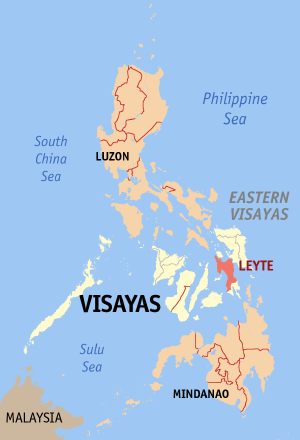Leyte
| Province of Leyte | |
Provincial seal of Leyte |
|
 Map of the Philippines with Leyte highlighted |
|
| Region | Eastern Visayas (Region VIII) |
| Capital | Tacloban City |
| Divisions | |
| - Highly urbanized cities | 0 |
| - Component cities | 3 |
| - Municipalities | 41 |
| - Barangays | 1,641 |
| - Congressional districts | 5 |
| Population | 14th largest |
| - Total (2007) | 1,592,336 |
| - Density | 279 /km² (723 /sq mi) (24th highest) |
| Area | 12th largest |
| - Total | 5,712.8 km2 (2,206 sq mi) |
| Founded | 1543 and March 10, 1917 |
| Spoken languages | Cebuano, Waray-Waray |
| Governor | Carlos Jericho Petilla (Lakas-CMD) |
Leyte is a province of the Philippines located in the Eastern Visayas region. Its capital is Tacloban City and occupies the northern three-quarters of the island of Leyte. Leyte is located west of Samar province, north of Southern Leyte and south of Biliran. To the west of Leyte across the Camotes Sea is the province of Cebu.
Contents |
History
The explorer Ruy López de Villalobos, first came to the island in 1543 and named it Las Islas Felipinas.
The Battle of Leyte Gulf took place in the seas surrounding this island from 23 October to 26 October 1944. It was the largest naval battle in modern history, when at least 212 Allied ships with the Filipino pilots clashed with the remnants of the Imperial Japanese Navy, some 60 ships, including the super battleships Yamato and Musashi.
The Battle of Leyte occurred on 20 October, 1944. A successful Allied invasion of the island was the crucial element to the eventual Filipino and American victory in the Philippines.



People and culture
The people of Leyte are divided into two main groups, primarily by language. In the west and south are the Cebuanos, while in the north and east are the Waray-waray.
The Cebuanos have ties with Cebu, the most populous province in the Visayas; the Warays are more tied to Leyte and Samar.
Economy
The economy of Leyte depends on agriculture. Rice is farmed in the lower flatter areas specifically those around Tacloban, while coconut farming, for coconut oil is the main cash crop of the more mountainous areas. Fishing is also a major source of livelihood among residents.
Although economically backward, the province is the site of the largest geothermal plant in Asia, making it one of the resource-rich provinces of the Philippines.
Geography
Political
Leyte is subdivided into 40 municipalities and 3 cities.
Ormoc City is an independent component city of Leyte. The city governs itself independent of the province and the residents do not vote for elective provincial officials, as stated in the city's charter.
Cities
- Ormoc City
- Tacloban City
- Baybay City
Municipalities
|
|
Official Provincial Seal
The Official Seal of the Province of Leyte.
The upper portion is a perspective of the national Freedom Park commemorating the landing of Gen. Douglas MacArthur and the American Liberation Forces in Leyte during World War II. The white cross represents the 2nd phase of Leyte's development when Magellan stopped here on his way to Cebu. The alphabet on the cross argent is the ancient visayan paleographic syllabary of the letter L which stands for Leyte. The stars around the inner circle symbolize the forty one (41) towns of Leyte and the everlasting flame symbolizes the soldiers who died during World War II.
See also
- Manuel Artigas
- Juan Ponce Sumuroy
External links
|
|||||||||||